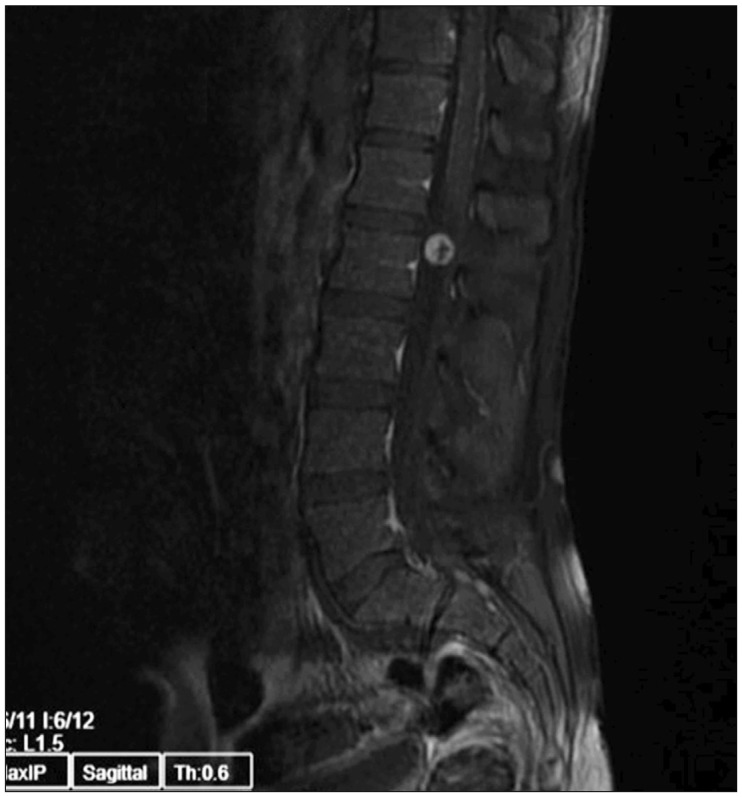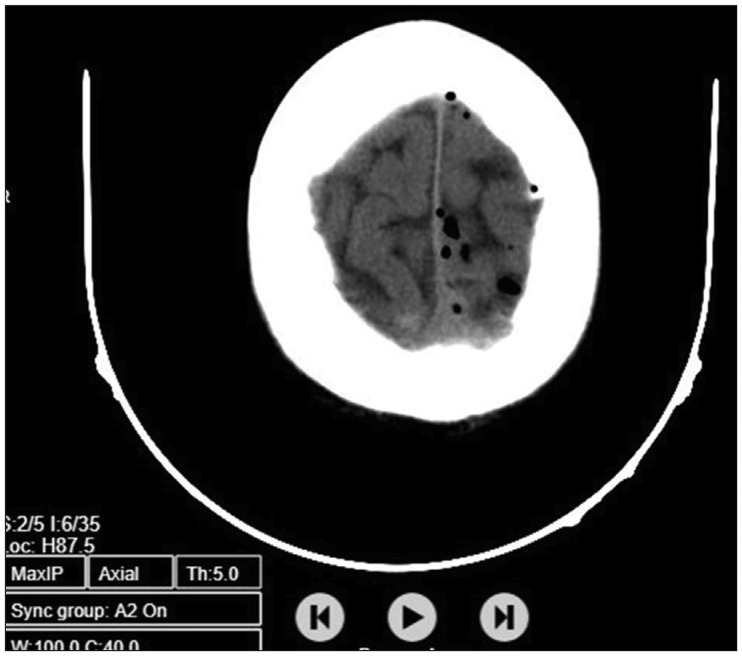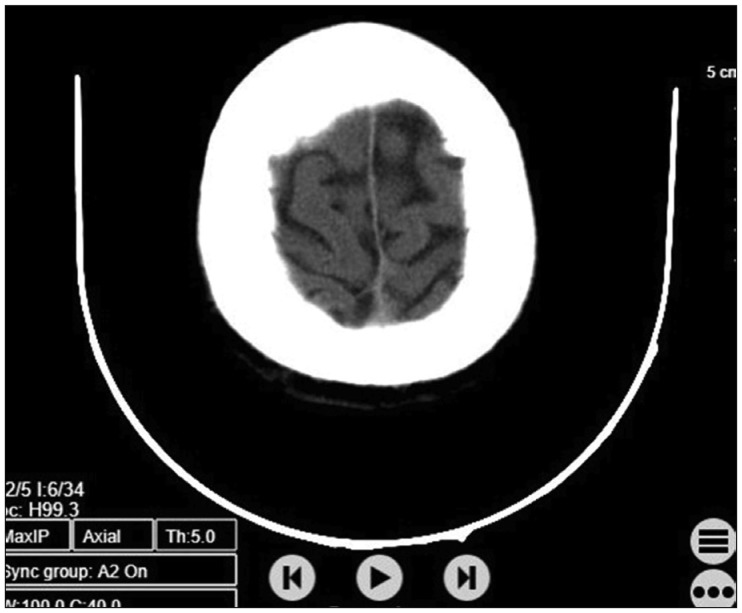Korean J Neurotrauma.
2017 Oct;13(2):176-179. 10.13004/kjnt.2017.13.2.176.
A Rare Complication of Lumbar Spinal Surgery: Pneumocephalus
- Affiliations
-
- 1Department of Neurosurgery, Ministry of Health, Beykoz State Hospital, Istanbul, Turkey. drmelcy3@gmail.com
- KMID: 2394557
- DOI: http://doi.org/10.13004/kjnt.2017.13.2.176
Abstract
- A 25-year-old male patient with severe thigh and right side pain was presented. In the lumbar magnetic resonance images, there was a contrasting spinal cord tumor image with 1 cm in diameter at the level of the L3 vertebra. The patient was operated and the tumor was totally removed. All the pain of the patient recovered. The patient's postoperative two days were very comfortable and the patient was early mobilized. On the third postoperative day, the patient complained of severe headache, nausea and vomiting. Immediate cranial computed tomography (CT) images was performed. Cerebral pneumocephalus was present in CT. The patient was treated with definite bed rest and plenty of fluid replacement. After three days, the patient's complaints were completely improved. This improvement was confirmed by performing a cerebral CT scan. In the formation of pneumocephalus, air is compressed into the intradural space during operation and this passes to the cerebral space. Definite bed rest, abundant fluid replacement and, in addition, highly inspired oxygen therapy are sufficient to correct the condition.
Keyword
MeSH Terms
Figure
Reference
-
1. Akyüz O, Gökpınar D, Aydin E, Aydin S, Duymuş M, Çığşar G, et al. Pneumocephalus and pneumorrhachis after spinal surgery. Pol J Radiol. 2016; 81:34–35. PMID: 26893792.
Article2. Andarcia-Bañuelos C, Cortés-García P, Herrera-Pérez MU, Deniz-Rodríguez B. Pneumocephalus: An unusual complication of lumbar arthrodesis. A clinical case and literature review. Rev Esp Cir Ortop Traumatol. 2015; 59:222–226. PMID: 24906529.
Article3. Ayberk G, Yaman ME, Ozveren MF. Symptomatic spontaneous pneumocephalus after spinal fusion for spondylolisthesis. J Clin Neurosci. 2010; 17:934–936. PMID: 20400320.
Article4. Baba M, Tarar O, Syed A. A rare case of spontaneous pneumocephalus associated with nontraumatic cerebrospinal fluid leak. Case Rep Neurol Med. 2016; 2016:1828461. PMID: 27217961.
Article5. Becker WJ. Pneumocephalus as a cause for headache. Can J Neurol Sci. 2002; 29:278–281. PMID: 12195619.
Article6. Chiari H. A case of acummulation of air in the ventricles of human brain. Z Heilkd. 1884; 5:383–390.7. Dhamija B, Saxena A. Pneumocephalus - a possible cause of post-spinal surgery confusion. J R Soc Med. 2011; 104:81–83. PMID: 21282798.8. Guarino AH, Wright NM. Pneumocephalus after a lumbar epidural steroid injection. Pain Physician. 2005; 8:239–241. PMID: 16850078.
Article9. Karavelioglu E, Eser O, Haktanir A. Pneumocephalus and pneumorrhachis after spinal surgery: case report and review of the literature. Neurol Med Chir (Tokyo). 2014; 54:405–407. PMID: 24305016.
Article10. Kim JS, Choi KC, Jung B, Lee SH. Symptomatic pneumocephalus after spinal intradural tumor surgery. J Korean Neurotraumatol Soc. 2008; 4:101–104.
Article11. Kizilay Z, Yilmaz A, Ismailoglu O. Symptomatic pneumocephalus after lumbar disc surgery: a case report. Open Access Maced J Med Sci. 2015; 3:143–145. PMID: 27275212.
Article12. Kozikowski GP, Cohen SP. Lumbar puncture associated with pneumocephalus: report of a case. Anesth Analg. 2004; 98:524–526. PMID: 14742399.
Article13. Lambert DH, Hurley RJ, Hertwig L, Datta S. Role of needle gauge and tip configuration in the production of lumbar puncture headache. Reg Anesth. 1997; 22:66–72. PMID: 9010949.
Article14. Paiva-Neto MA, Tella OI Jr. Supra-orbital keyhole removal of anterior fossa and parasellar meningiomas. Arq Neuropsiquiatr. 2010; 68:418–423. PMID: 20602048.
Article15. Paiva WS, de Andrade AF, Figueiredo EG, Amorim RL, Prudente M, Teixeira MJ. Effects of hyperbaric oxygenation therapy on symptomatic pneumocephalus. Ther Clin Risk Manag. 2014; 10:769–773. PMID: 25328392.
Article16. Roberts GA, Foy PM, Bolger C. Idiopathic spontaneous cerebrospinal fluid rhinorrhoea and pneumocephalus: case report and literature review. Br J Neurosurg. 1996; 10:513–517. PMID: 8922715.
Article17. Torres A, Holoye PY, Camacho LH. Spontaneous pneumocephalus associated with recurrent colorectal carcinoma. J Clin Oncol. 2008; 26:5483–5484. PMID: 18955437.
Article18. Toung TJ, McPherson RW, Ahn H, Donham RT, Alano J, Long D. Pneumocephalus: effects of patient position on the incidence and location of aerocele after posterior fossa and upper cervical cord surgery. Anesth Analg. 1986; 65:65–70. PMID: 3455673.19. Venkatesh SK, Bhargava V. Clinics in diagnostic imaging (119). Post-traumatic intracerebral pneumatocele. Singapore Med. J. 2007; 48:1055–1059.
- Full Text Links
- Actions
-
Cited
- CITED
-
- Close
- Share
- Similar articles
-
- Tension Pneumocephalus after Transsphenoidal Surgery: Report of Two Cases
- Diffuse Pneumocephalus : A Rare Complication of Spinal Surgery
- Tension Pneumocephalus after Transsphenoidal Surgery for a Giant Pituitary Tumor: Case Report
- Extensive Tension Pneumocephalus Caused by Spinal Tapping in a Patient with Basal Skull Fracture and Pneumothorax
- Pneumocephalus in a Patient with No Cerebrospinal Fluid Leakage after Lumbar Epidural Block: A Case Report




